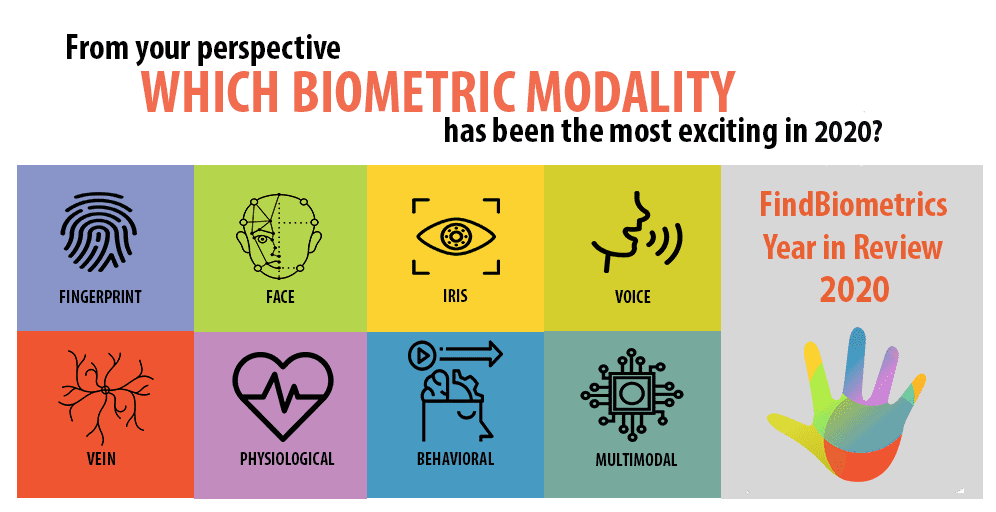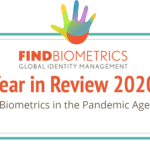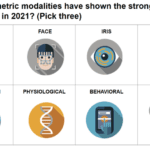
The results of the FindBiometrics Year in Review survey for 2020 are in – with over 900 total respondents offering their opinions on the biometrics and identity management trends of the past 12 months. It was a wild year, and the impact of COVID-19 was certainly expected to shake things up in our annual survey results. And as we begin to unpack the data, we’ve already encountered our first surprise with respect to the question of which biometric modality was most exciting in 2020.
The question has been dominated by two modalities in recent years: face and fingerprint biometrics. Fingerprint recognition was, of course, central to the mobile biometrics revolution over the past several years. Facial recognition, meanwhile, has gained considerable prominence in recent years thanks to the rise of selfie-based authentication on consumer devices, and due to intensifying media attention concerning the use of facial recognition by law enforcement and other government authorities.
Understandably, facial recognition was voted the most exciting modality of 2019 in last year’s Year in Review survey, while fingerprint recognition came in second. They took 37 percent and 14 percent of the vote, respectively, in results that are nearly identical to those of the year before.
Then came the plague year, and things changed. In the results of the latest FindBiometrics Year in Review survey, facial recognition has retained the top spot as the year’s most exciting modality, but iris recognition has pulled ahead of fingerprint biometrics by a considerable margin – 23 percent of the vote, compared to the latter’s 12 percent. Face biometrics took 38.5 percent of the vote.

The most obvious way to interpret this change is to understand it as a reflection of the excitement around contactless biometrics in 2020. And that’s a direct result of COVID-19. The virus is primarily transmitted through the air, but shared surfaces are a matter of serious concern as well, and this has prompted a shift away from things like shared fingerprint readers used to gain access to a facility, or to clock in for work.
Face and iris biometrics, meanwhile, don’t require physical contact, and have been embraced across a range of sectors and applications in the wake of the pandemic. Even in cases where these biometrics were already in use, such as the Department of Homeland Security’s expanding airport screening program, their contactless nature has been emphasized as another reason for their deployment.
All that having been said, fingerprint biometrics still ranks third, and took way more of the vote than other exciting modalities like behavioral biometrics (which took just under four percent) and voice recognition (just over two percent). That’s probably a testament to the technology’s ongoing evolution, its staying power in the mobile sector, and its emergence in newer applications.
2020 saw a steady flow of new mobile device launches in which fingerprint sensors were embedded under the device display, representing the latest and most hi-tech iteration of mobile fingerprint sensor technology. Meanwhile, throughout the year excitement continued to build over the emergence of biometric payment cards featuring embedded fingerprint sensor technology, with large-scale launches anticipated for 2021.
Notably, these are single-user applications of fingerprint recognition: generally speaking, a given smartphone isn’t shared among multiple people, while the whole point of biometric payment cards is that only the registered cardholder can authorize a payment. COVID-related concerns about shared surfaces do not apply to these use cases, offering fingerprint biometrics some staying power in the Year in Review survey.
Finally, it’s worth noting that a lot of survey respondents showed appreciation for multimodality. About 8.5 percent of the votes went to the multimodal option, making it the fourth-place result. It’s a bit of a trick answer, but it helps to illustrate the appetite for multimodal approaches to biometric security among industry professionals who are well-informed about its benefits.
More intriguing results are in the pipeline as we continue to analyze the Year in Review survey results, so stay tuned for more in-depth coverage in the coming days and weeks.
*
The 2020 FindBiometrics Year in Review is made possible by our sponsors: Aware, BioConnect, FacePhi, Innovatrics, Jumio, NEC Corporation of America, and Onfido.
–
January 19, 2020 – by Alex Perala









Follow Us